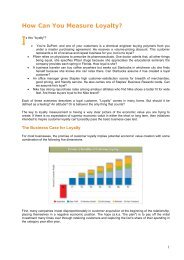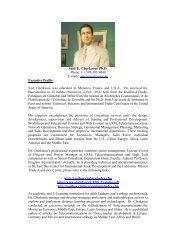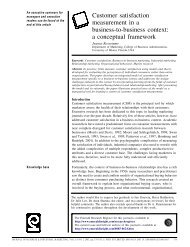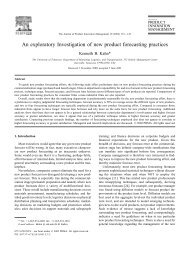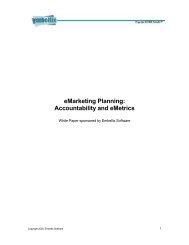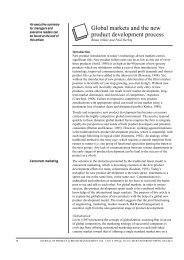The Executive's Guide to Branding
The Executive's Guide to Branding
The Executive's Guide to Branding
Create successful ePaper yourself
Turn your PDF publications into a flip-book with our unique Google optimized e-Paper software.
Enhanced loyalty also reduces the volatility of cash-flow as the cus<strong>to</strong>mer<br />
base is less likely <strong>to</strong> switch, keeping demand more stable.<br />
While brand loyalty is expected <strong>to</strong> result in lower volatility and vulnerability<br />
of cash flows and therefore corporate risk, can this be also be expected <strong>to</strong><br />
reduce the cost of capital?<br />
<strong>The</strong> firm’s <strong>to</strong>tal cost of capital is expressed as the WACC (Weighted Average<br />
Cost of Capital). <strong>The</strong> WACC combines the cost of debt with the cost of equity.<br />
Both components can be expected <strong>to</strong> decrease with a reduction in business<br />
risk associated with the firm’s operations. Several fac<strong>to</strong>rs suggest that<br />
companies with strong brands will face lower business risk. Persistence of<br />
lower business risk should lead <strong>to</strong> lower cost of capital. Contributing fac<strong>to</strong>rs<br />
include:<br />
Demand variability - the more stable, the lower the business risk.<br />
Sales price variability - the less variable the lower the business risk.<br />
Input price variability - the less variable the lower the business risk.<br />
Market pricing power – elasticity of demand – higher brand loyalty<br />
implies lower price elasticity and therefore lower business risk<br />
<strong>The</strong>refore, lowering the risk in the firms’ cash flows reduces the cost of<br />
capital <strong>to</strong> the firm.<br />
Some recent findings suggest that trust and lower perceived risk associated<br />
with branded products may carry over in<strong>to</strong> securities. That is, consumers<br />
who have a positive ownership experience with GE appliances just might<br />
think that the General Electric Company is a good (higher return, lower risk)<br />
bet. This suggests that, ceteris paribus (all other things being equal), for<br />
firms with better corporate reputations, inves<strong>to</strong>rs should be willing <strong>to</strong> accept:<br />
Higher financial risk (Beta) for same return<br />
Lower return for same Beta<br />
Either of these will reduce the cost of capital and therefore increase market<br />
capitalization. Using the Fortune Corporate Reputation Index as a measure of<br />
corporate brand equity, recent studies have shown that the cost of capital<br />
difference between the “best” and “worst” reputation firms can be as much<br />
as 0.5 percent, depending on the industry.<br />
1. Do strong brands result in growth and acceleration of cash flows?<br />
A dollar in the pocket <strong>to</strong>day is better than one a year from now. Earlier cash<br />
flows are preferred because risk and time adjustments reduce the value of<br />
later cash flows. Strong brands lead <strong>to</strong> cash flow acceleration due <strong>to</strong> more<br />
rapid market penetration (enhanced diffusion of innovation). Strong brands<br />
improve market penetration because brands reduce the perceived risk for the<br />
Zyman Institute of Brand Science – Perspectives 11




